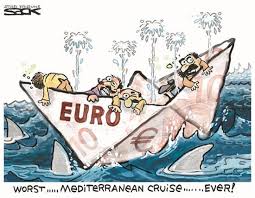“The US had one financial crisis in 2008, but Europe has had two crises—2008 and 2011,” said Philippe Ithurbide, Global Head of Research, Analysis, and Strategy at Amundi Asset Management. He was addressing members of the CFA Society Toronto that had gathered in the TMX Group Centre in downtown Toronto on the evening of November 19, 2013 to hear an overview of European market trends.
The first half of his talk was a comprehensive quantified description of the financial woes of the euro zone, followed by several proposed solutions and investments strategies in the second half.
 In the quarters since the 2008 meltdown, the gross domestic product (GDP) in volume has more than recovered from its Q4 2007 level for the US, but it is still struggling to attain that level for the UK, Japan, and the euro zone. The financial stress is decreasing, but Ithurbide showed there was a stark contrast between the “core” euro zone and “peripheral” countries. He defined the core as France, Germany, Netherlands, Austria, and Belgium, noting that France “is more of an ‘in-between’ case although it is perceived as core.”
In the quarters since the 2008 meltdown, the gross domestic product (GDP) in volume has more than recovered from its Q4 2007 level for the US, but it is still struggling to attain that level for the UK, Japan, and the euro zone. The financial stress is decreasing, but Ithurbide showed there was a stark contrast between the “core” euro zone and “peripheral” countries. He defined the core as France, Germany, Netherlands, Austria, and Belgium, noting that France “is more of an ‘in-between’ case although it is perceived as core.”
The rebound in the GDP has to be put into perspective, Ithurbide said. Germany, France, Italy, and Spain account for nearly 80 percent of the euro zone GDP and of these, Italy and Spain are having difficulty. “The recession is more severe in Italy than Spain,” he said.
In the peripheral nations, “some kind of deflation” appears to be happening, with wages being cut by as much as 30 to 50 percent. Private investment has not rebounded in any European country except Germany. “Although Spain has been a favourite investment country this past year,” he cautioned, “this does not mean Spain is suddenly solvent.”
The upcoming Asset Quality Review (AQR) is expected to clean up bad debt on bank balance sheets and restore confidence. Ithurbide compared trends in European house prices among several countries. Relative to their 2007 levels, Sweden, the UK, and France have rebounded, and Germany has exceeded. The trend in non-performing loans (NPLs) shows that Spain and Italy are still rising, Spain precipitously so.
Ithurbide doubted there would be respite on unemployment in the coming year. He suggested IMF unemployment forecasts might be too optimistic.
 Competitiveness arises from three sources: currency, cost, and quality of product. Since the euro has fallen by about 20 percent, that has helped competitiveness across the board. Ithurbide showed that Italy and France, which did not increase their exports outside the euro zone, had lower competitiveness than Germany and Spain, both of which aggressively increased targets outside the euro zone.
Competitiveness arises from three sources: currency, cost, and quality of product. Since the euro has fallen by about 20 percent, that has helped competitiveness across the board. Ithurbide showed that Italy and France, which did not increase their exports outside the euro zone, had lower competitiveness than Germany and Spain, both of which aggressively increased targets outside the euro zone.
“Spain is not out of the woods yet,” said Ithurbide. His analysis of GDP, excess bank credit, and private debt led him to conclude, “we think there are another 6 to 9 months of deleveraging that will occur in Spain.” ª
The research paper at Amundi Asset Management related to this talk can be found at: http://research-center.amundi.com/

